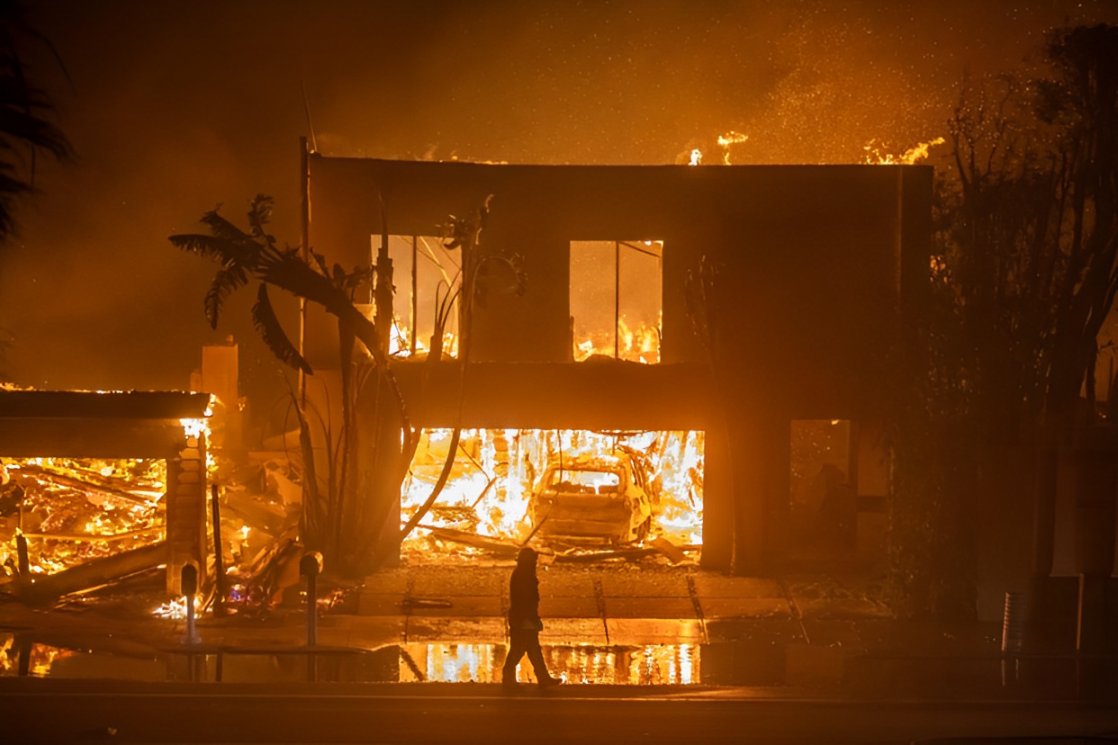Waking up to the news this morning in Los Angeles was devastating for many. Five major wildfires have ravaged the city, consuming nearly 14,000 acres of land. This is now being recognized as one of the most destructive wildfire seasons in the city’s history.
As the fires rage on, the death toll has reached five, and nearly 180,000 people are under evacuation orders. The damage to homes, businesses, and neighborhoods is catastrophic, with some areas looking as if “a bomb had been dropped on them,” as a local sheriff described it to CNN.
While the damage to property is severe, there is an even greater concern for the health of those living in Los Angeles and surrounding regions. Wildfire smoke, now spreading through the area, is a serious threat to public health. According to AirNow, a trusted source for air quality information, parts of Southern California are experiencing hazardous air conditions with an unhealthy air quality index.
What Is Wildfire Smoke Made Of?
Wildfire smoke is not just smoke from burning trees. It contains a mixture of harmful gases, particles, and chemicals. The U.S. Environmental Protection Agency (EPA) describes wildfire smoke as a blend of gases like carbon monoxide, volatile organic compounds, and particulate matter. These pollutants arise from burning plants, trees, and other materials, both naturally and from human activity.
One of the most concerning components of wildfire smoke is particulate pollution, which consists of tiny solid and liquid particles that can easily enter the lungs. These particles are not only harmful to breathe in but also represent a significant public health risk, according to the EPA.
This mixture of chemicals in the air is being referred to as a “toxic soup” by experts like Lisa Miller, a wildfire smoke specialist at the University of California, Davis. She warns that the materials we use every day—such as synthetic fibers in carpets, furniture, and clothing—are also burning in these wildfires, releasing even more dangerous toxins into the air.
Why Is Wildfire Smoke Dangerous for Health?
Exposure to wildfire smoke can cause both short-term and long-term health problems. According to the EPA, people exposed to this smoke may experience coughing, irritated eyes, and difficulty breathing. In addition to these common symptoms, smoke inhalation can lead to inflammation in the lungs, raising the risk of conditions like bronchitis and making asthma symptoms worse.
More severe effects can include problems with heart health. People with pre-existing heart conditions, such as heart disease, are at higher risk of heart attacks, strokes, and other cardiovascular problems due to exposure to smoke. The National Institutes of Health also suggests that long-term exposure to wildfire smoke may increase the risk of developing dementia.
It is particularly dangerous for older adults, children, and anyone with respiratory or heart conditions. As wildfire seasons grow more intense due to climate change, understanding the health risks and protecting oneself from exposure becomes even more critical.
How Wildfire Smoke Affects Different Groups
Different groups of people are more vulnerable to the harmful effects of wildfire smoke. Children, the elderly, and individuals with respiratory conditions like asthma or chronic obstructive pulmonary disease (COPD) are especially at risk. This is because their lungs and immune systems may be weaker, making it harder for them to fight off the effects of toxic smoke.
Additionally, people who work outdoors or live in areas with frequent exposure to wildfires are at a higher risk due to prolonged exposure. First responders and firefighters who work closely with the fires are also more vulnerable to serious health effects, both short-term and long-term.
Protecting Yourself from Wildfire Smoke
During wildfire season, the most important thing people can do is stay informed about the air quality in their area. Health experts like Dr. Muntu Davis, the health officer for Los Angeles County, recommend monitoring the air quality index regularly and taking preventive steps to protect yourself and your family.
Here are some key precautions you can take to reduce the impact of wildfire smoke on your health:
- Stay indoors: If air quality is poor, avoid going outside. Keep windows and doors closed to prevent smoke from entering your home.
- Use air conditioning wisely: Use air conditioners to circulate indoor air, but avoid using those that bring outdoor air inside.
- Wear protective masks: When stepping outside is unavoidable, wear an N95 or P100 mask to protect your lungs from harmful particles.
- Create a clean indoor environment: If possible, use air purifiers in your home to filter out harmful particles from the air.
- Take health precautions: If you experience symptoms like coughing or difficulty breathing, it’s essential to seek medical attention.
Long-Term Effects and Future Risks
As wildfires continue to grow in frequency and intensity, health experts warn that the long-term effects of exposure to wildfire smoke could be severe. Not only does this smoke affect the lungs and cardiovascular system, but it may also have an impact on mental health, especially for those who experience prolonged exposure.
Experts continue to study the full scope of wildfire smoke’s effects on human health, but it is clear that the health risks are significant. Governments and health agencies are urging people to take precautions seriously and follow the advice of health experts during wildfire season.
Conclusion
Southern California’s wildfires are a powerful reminder of the destructive force of nature and the critical importance of taking precautions to protect our health. The toxic smoke from these fires poses serious risks to the health of residents, particularly those with pre-existing conditions.
By staying informed, taking steps to limit exposure, and caring for vulnerable populations, individuals can reduce their risk and safeguard their well-being during these challenging times.
Disclaimer: This article has been meticulously fact-checked by our team to ensure accuracy and uphold transparency. We strive to deliver trustworthy and dependable content to our readers.







Leave a Comment